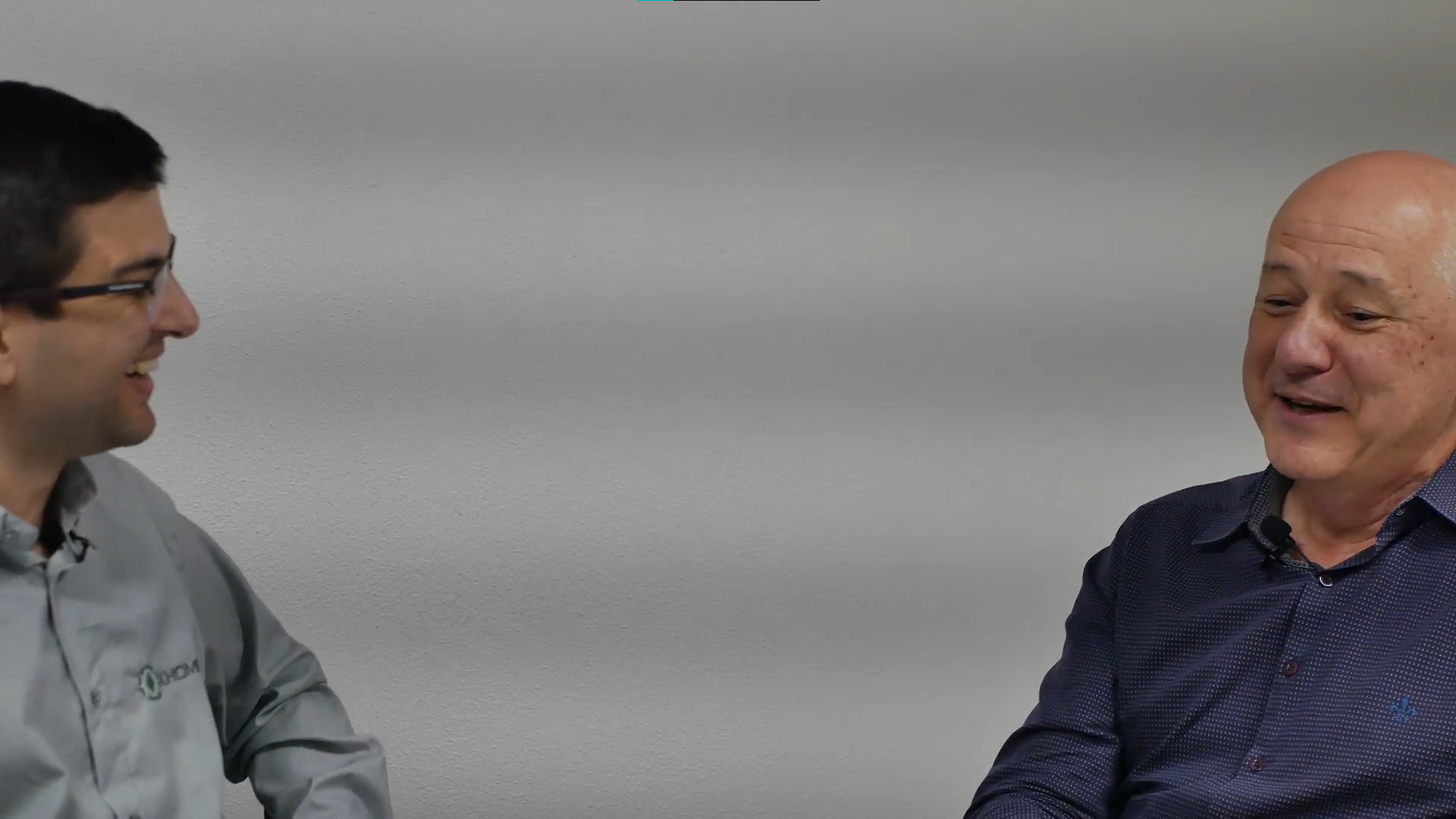
In an interview with Khomp, Fábio Santana, IT Superintendent at Grupo Connvert, talks about the bottlenecks and opportunities in relation to the latest regulations for Contact Centers.
Among ANATEL’s new regulations, the one with the greatest impact on both consumers and Contact Center companies was the rule that requires any call offering products or services to be identified by the code 0303 as a prefix.
The main objective of the new regulation is to standardize calls and allow the user to identify the intention of the person on the other end of the line. The impact, of course, was felt by companies in the sector that had to adapt and now face even more challenges to keep their teams operating.
To clarify this and other regulations, our director of strategy and exports Ygor Voltoni spoke with Fábio Santana, IT Superintendent, Information Security and Data Protection at Grupo Connvert (Flex BPO + Code7 + CX design). Check out the interview!
Khomp: We recently had changes in a series of precautionary measures by Anatel that ended up being called the “Regulatory Guillotine.” Among these numerous changes, we can highlight the regulation of 0303, the billing from the second 0, the limit of up to 100,000 calls per trunk per operator… All of this had a huge impact on Contact Centers. Tell us a little about how Flex sees this movement?
Fábio Santana: It was interesting how you said it: “Guillotine.” This had a huge impact on the Contact Center BPO area, both in the initial sales service area, but also in the billing area.
Of all these measures that you mentioned, if we were to evaluate, the 0303 was the only measure that we had more time to analyze. Although the measure was detailed later, the period between the announcement of the measure and its implementation was approximately 7 months. During this period, we had time to adapt, although it wasn’t necessarily the BPO, but rather the owner of the product being sold, who needed to adapt to this legislation, and these companies started working on this very close to the deadline for adaptation.
It was a huge challenge to have 0303, due to the deadline and because it was a very big change, because there is a technical part and a planning part. We had to change the entire way we approach our customers. I have to think that my customer will always start receiving a fixed number, and we know that there are several cell phones and applications that block and send spam, and they are not necessarily regulated, so they can put a number that you want to receive in the spam, taking away the opportunity for you to receive an interesting offer, for example from your bank. This is an assessment that we made, but it is possible to say that this is indeed reducing not only sales, but also the connection with people.
Of course, on the other hand, 0303 is the number of bank X or company Y, so as time goes by, the person learns that that number belongs to a certain company and the marketing departments of the companies are able to work on these points with customers.

Regarding the other measures, charging after 0 seconds, for example, is not only for Contact Centers, it is for all existing phones, so this is a point that is sometimes not talked about, but for anyone who has a phone this measure also applies and this can increase your bill. But we have some differences and we had little time to adapt. The measure came out after we had 15 to 20 days and in many of these situations the operators were not prepared to account for it, nor were we fully prepared.
Of course, some companies like Flex already had technologies that helped us at that time to actually implement the changes, for example, precautionary measure 160, which limits non-productive calls to 100,000, which are calls: busy, operator message, non-existent phone… All of this is counted within the 100,000, as well as the calls that I connected to an answering machine or a person and that lasted up to 3 seconds, so all of this here during a day is a number of 100,000, but there are things that are not necessarily within our management. How many calls will go unanswered? We know that statistically, but this is a variable in relation to operations, so we had to create solutions in a very short time that block, that is, that do not exceed 100,000, precisely to meet the needs and these solutions needed to be both technical and planning.
What is planning? You have to be more assertive, you have to dial less, you have to try to call the person in a more coherent way, not spending so much, reducing the number of attempts during the day for the customer, that is, also doing what Anatel requested. But I also need to control the 100,000 calls there in my call center, so for example, technologies like those that Khomp has, which with some configurations have been able to help us a lot in not exceeding this limit according to the established rules, because it keeps control, if it is reaching a trunk close to 100,000, it no longer allows the use of that trunk, so that it does not exceed those 100,000 calls per day.
Another case was the issue of 3 seconds, in which in the past the initial 3 seconds of the call were not charged and now Anatel has defined that they have to be charged. These 3 seconds are normally used by telephony platforms to detect when there is a voicemail, answering machine, or a message from a non-existent number, because some situations do not come through signaling, so this is a problem that used to occur, which is why the operators gave this “discount”, they did not charge for these three seconds due to their own regulations regarding this, and they took this away from everyone, so what happens?
I have to start using technologies that increasingly evaluate the pre-connect, because if I do nothing, the cost of telephony becomes very high, our calculation is that it would increase telephony by 91%, because I will not only spend the 3 seconds, there is what we call telephone cadence, when I start working most operators charge for the first 30 seconds, so if before I did not pay anything, now I pay for 30 seconds, of a call that sometimes takes 40 seconds. I have a very high financial cost involved in this, so pre-connect solutions like the ones we have from Khomp, I can make an early assessment. The sooner I can make this assessment, the sooner I will be able to detect that that call is not a call that interests me and with that I will not spend money. These technologies helped us, together with the practical policies that we revitalized within the company’s planning area.
Of course, everything I mentioned happened very last minute, so we worked to be able to do this, but I know that many companies had problems, because all these changes do not happen overnight. The operators themselves are still having problems accounting for the numbers of 100 thousand because their billing systems were not prepared to account for unconnected calls. Until then, the concern was only with the connected call and that is why the operators are having such difficulty in having the correct numbers. It is not easy to have all this, to have a database, to store this information that for us is a volume, and imagine the volume for the operators.
Khomp: And all of this in real time, right, Fábio? Considering that there are several operators, each with its own Core infrastructure. And you are also multiplatform here, you work with several platforms and dialers, how do you centralize all this data? Standardize and have a single control so that you don’t exceed 100 thousand calls and mitigate the risk of your operations. I think that was the main challenge to be overcome, right?
Fábio Santana: We can’t just pay to see, we need to deal with this differently, so this issue is very important, given our size, where we have more than one data center spread throughout the country, with different connections, different carriers, this was also a challenge for us. The 0303 customer would come to us and say: look, take my 0303 and use it with carrier Y, then I would come and say, but I use this customer here on the site in such and such region, but I only have this carrier at the other data center. So what am I going to do? Thank goodness we have vSBC, which allowed me to route the call properly within our structure, and with that I was able to respond more quickly.
Here we had a lot of internal acculturation work and conversations with our customers, explaining technically and legally all the information about the measures. Many customers thought it would not come into effect and when June came, that was when the rush began, especially with the technical part, how do I put all this into effect? This structure that we have with the equipment allowed us to quickly resolve situations, connect on one side, transfer on the other… This helped us in this process of learning quickly, without leaving a customer limited.
This is a very interesting insight that we noticed in this process, we joke that it was almost a “millennium bug” because it was a very intense work for people to understand or reconfigure their structure to adequately comply with the policies without losing too much productivity. Stop and understand a little more before dialing.
The interview continues and, soon, check out the second part of this conversation with more details and solutions for this new moment in the Contact Center area!
Want to learn more about this topic?
10 most common problems and how to solve them
For more information, download our e-book: SOS Contact Center Outbound. In this study, you will find out in more detail how Khomp can help solve these and many other common problems in the sector.